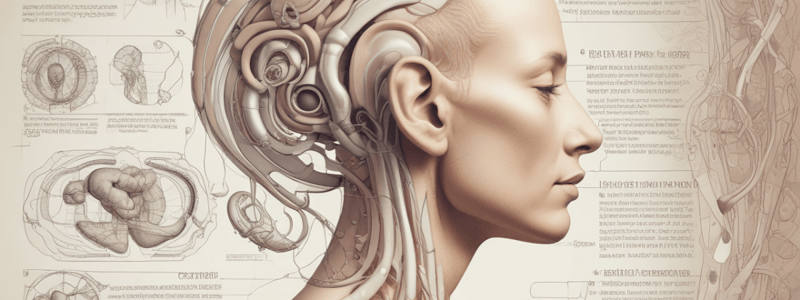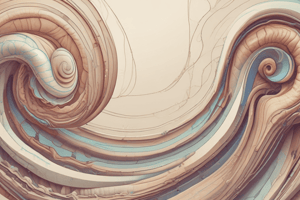Podcast
Questions and Answers
What is the primary composition difference between perilymph and endolymph?
What is the primary composition difference between perilymph and endolymph?
- Perilymph contains high sodium concentration, while endolymph contains equal sodium and potassium concentrations.
- Perilymph is secreted by epithelial cells, whereas endolymph originates from plasma.
- Perilymph has high potassium concentration, while endolymph has low potassium concentration.
- Perilymph is similar to extracellular fluid, while endolymph is similar to intracellular fluid. (correct)
Which statement accurately describes the fluid dynamics within the cochlea?
Which statement accurately describes the fluid dynamics within the cochlea?
- Perilymph is found in the cochlear duct.
- Endolymph has a lower potassium concentration than perilymph.
- Endolymph has a high potassium concentration and is in the cochlear duct. (correct)
- Both perilymph and endolymph are secreted by epithelial cells.
What distinguishes the ionic composition of endolymph from that of extracellular fluid?
What distinguishes the ionic composition of endolymph from that of extracellular fluid?
- Extracellular fluid has more potassium than endolymph.
- Extracellular fluid has no potassium content.
- Endolymph is low in sodium and high in potassium. (correct)
- Endolymph has a high sodium concentration compared to extracellular fluid.
Which component of the cochlea is similar to plasma?
Which component of the cochlea is similar to plasma?
Which characteristic is true regarding the secretion of endolymph?
Which characteristic is true regarding the secretion of endolymph?
What combination of compartments constitutes the Extracellular Fluid (ECF)?
What combination of compartments constitutes the Extracellular Fluid (ECF)?
Which of the following best describes the role of capillary walls in body fluid compartments?
Which of the following best describes the role of capillary walls in body fluid compartments?
What is the primary fluid compartment where you would find blood cells?
What is the primary fluid compartment where you would find blood cells?
Which statement is accurate regarding intracellular fluid (ICF)?
Which statement is accurate regarding intracellular fluid (ICF)?
Which components are correctly identified in the body fluid compartments layout?
Which components are correctly identified in the body fluid compartments layout?
Which structure within the cochlea is primarily responsible for transmitting sound signals to the auditory cortex?
Which structure within the cochlea is primarily responsible for transmitting sound signals to the auditory cortex?
Which component of the cochlea plays a crucial role in mechanical transduction of sound waves into neural signals?
Which component of the cochlea plays a crucial role in mechanical transduction of sound waves into neural signals?
What role does the tectorial membrane play in the cochlea's function?
What role does the tectorial membrane play in the cochlea's function?
Which part of the cochlea is involved in separating different fluid compartments?
Which part of the cochlea is involved in separating different fluid compartments?
Which duct in the cochlea is located above the cochlear duct?
Which duct in the cochlea is located above the cochlear duct?
Flashcards are hidden until you start studying
Study Notes
Cochlea Structure and Fluids
- Cochlea consists of three main ducts: vestibular duct, cochlear duct, and tympanic duct.
- Perilymph is found in the vestibular and tympanic ducts.
- Composition is similar to blood plasma.
- Endolymph occupies the cochlear duct.
- Secreted by specialized epithelial cells lining the cochlear duct.
- Mimics intracellular fluid in composition.
- Notably high potassium concentration ([K+]), crucial for sensory function.
Fluid Composition Overview
- Endolymph has elevated levels of potassium ([K+]).
- Intracellular and extracellular fluids have higher sodium concentration ([Na+]).
- Unique ionic environment is essential for the electrochemical gradients necessary for hearing.
Body Fluid Compartments
- Body fluids are segregated into distinct compartments, which are divided by cell membranes and capillary walls.
- The primary body fluid compartments include blood cells, blood vessels, plasma, interstitial fluid, and intracellular fluid.
Compartments Details
- Blood cells: Comprise the cellular components within blood, including red blood cells, white blood cells, and platelets.
- Blood vessel: Acts as a conduit for blood flow throughout the circulatory system.
- Plasma: The liquid component of blood, which carries cells, nutrients, hormones, and waste products.
- Interstitial fluid: The fluid that exists in the spaces between cells, facilitating nutrient and waste exchange.
- Intracellular fluid: The fluid contained within cells, critical for cellular processes and metabolism.
Structural Boundaries
- Capillary wall: A selectively permeable barrier that separates blood from interstitial fluid, allowing for the exchange of substances.
- Cell membrane: Encloses the intracellular fluid, regulating the entry and exit of substances in and out of cells.
Abbreviations
- ECF (Extracellular Fluid): Refers to the extracellular fluid compartment, which includes both interstitial fluid and plasma.
- ICF (Intracellular Fluid): Designates the intracellular fluid compartment that exists within cell membranes.
Cochlea Structure
- The cochlea features a bony cochlear wall that protects its internal structure.
- The vestibular duct (scala vestibuli) contains perilymph and is located above the cochlear duct.
- The cochlear duct (scala media) houses the organ of Corti and contains endolymph, vital for hearing.
- The tectorial membrane is a gelatinous structure that sits atop the organ of Corti and plays a role in stimulating hair cells.
- The organ of Corti contains hair cells, which are essential for transducing sound vibrations into neural signals.
- The tympanic duct (scala tympani) is another chamber filled with perilymph and located below the cochlear duct.
- The basilar membrane supports the organ of Corti and vibrates in response to sound waves, allowing for sound frequency discrimination.
Cochlear Nerve Function
- The cochlear nerve transmits action potentials generated by hair cells directly to the auditory cortex, facilitating sound perception.
Studying That Suits You
Use AI to generate personalized quizzes and flashcards to suit your learning preferences.



